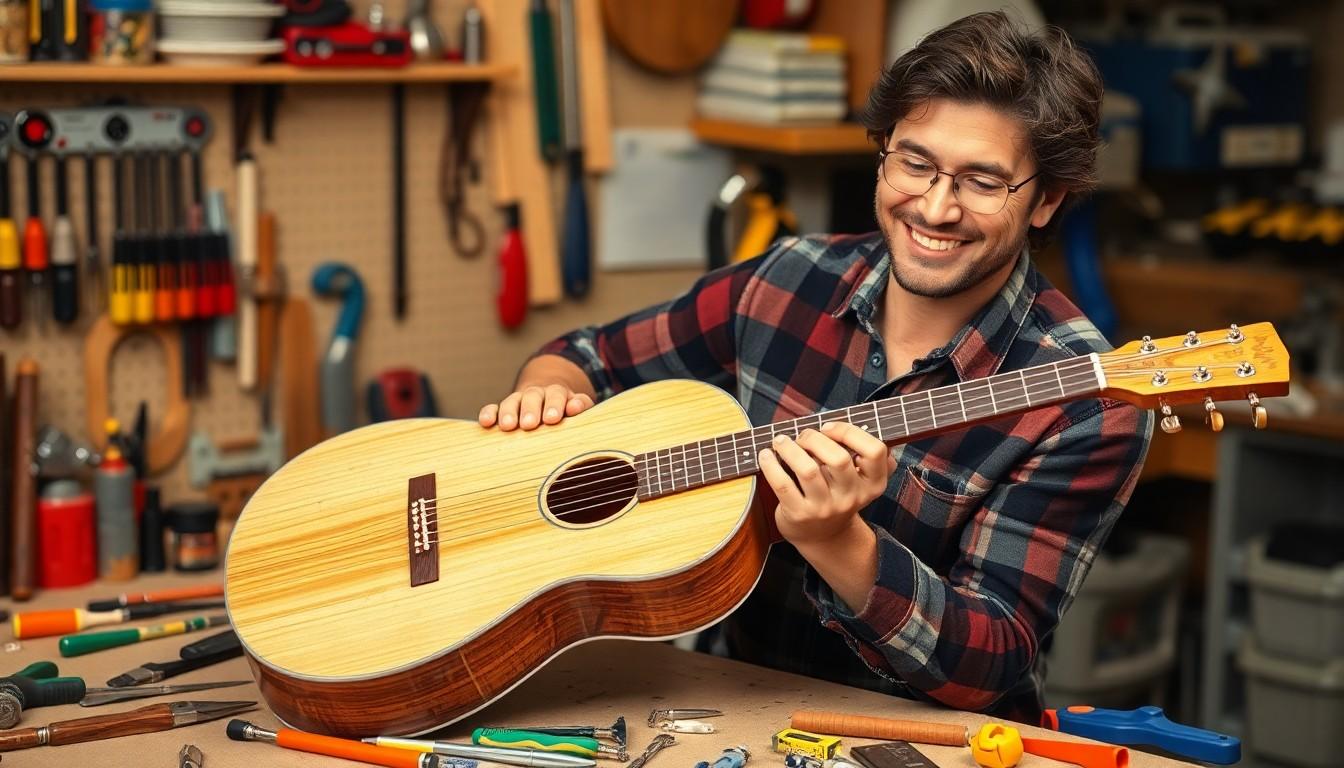
Best Guitar Kits 2024: Top DIY Builds for Every Skill Level & Budget
Building a custom guitar from scratch isn’t just for seasoned luthiers anymore. Guitar kits have revolutionized how music enthusiasts can create their dream instruments without breaking the bank or needing years of woodworking experience. From classic Stratocaster-style builds to exotic flying V designs these DIY projects offer an exciting way to understand guitar construction while crafting something unique.
Whether someone’s a beginner looking to learn the basics or an experienced player wanting to customize their sound guitar kits provide all the necessary components and instructions. They’ve become increasingly popular as manufacturers improve quality and expand options. The best part? That incredible feeling of plugging in and playing the first chord on a guitar they’ve built with their own hands. It’s like cooking a gourmet meal instead of ordering takeout – sure both fill you up but there’s something special about creating it yourself.
Best Guitar Kits
DIY guitar kits contain pre-cut wooden components ready for assembly into a complete instrument. Each kit includes essential parts like the body, neck, bridge, tuning machines, pickups, electronics, hardware, strings plus detailed assembly instructions.
Components in a standard guitar kit:
- Pre-shaped body blank made from tone woods like mahogany, alder or basswood
- Pre-carved neck with installed frets and truss rod
- Bridge system matched to the body style
- Set of tuning machines for string adjustment
- Pickups appropriate for the guitar type
- Electronic components including potentiometers, switches and wiring
- Hardware package with screws, string trees and mounting plates
- Detailed step-by-step assembly guide
Two main categories of guitar kits exist:
- Bolt-on Neck Kits: Feature separate neck and body pieces that connect via screws for easier assembly
- Set Neck Kits: Require permanent gluing of the neck to the body for enhanced sustain
Guitar kit styles available:
- Stratocaster-style electric guitars
- Les Paul-style solid bodies
- Telecaster replicas
- Bass guitar variants
- Hollow body jazz guitars
- Flying V and Explorer shapes
The quality levels range from basic starter kits at $100 to premium packages at $500+. Most kits require basic tools like screwdrivers, wrenches, files for final setup adjustments after assembly. The building process takes 8-15 hours depending on the kit complexity and desired finish quality.
Benefits of Building Your Own Guitar

Building a guitar from a kit offers distinct advantages over purchasing a pre-built instrument. The experience combines practical skills development with creative expression while providing significant value.
Cost Savings vs Pre-Built Guitars
A guitar kit costs 40-60% less than a comparable pre-built model. Entry-level kits start at $100 while similar factory-made guitars retail for $250-300. Mid-range kits priced at $300-400 match the quality of manufactured guitars in the $700-900 range. Premium kits featuring high-end components like Seymour Duncan pickups cost $500-600 compared to $1,200-1,500 for equivalent pre-built guitars. The cost savings extend to customization options, as upgrading components individually through a kit eliminates the markup on factory-installed premium features.
Customization Options
Guitar kits enable complete control over the final instrument’s appearance features. Builders choose from multiple finish options including natural wood stains translucent colors solid paint jobs. The electronics configuration accommodates various pickup combinations: single-coils humbuckers P90s active pickups. Hardware customization includes bridge styles (tune-o-matic floating tremolo hardtail) tuning machines (locking standard vintage) nut materials (bone plastic graphite). Decorative elements like binding inlays custom pickguards allow for unique aesthetic touches. The neck profile shape fretboard radius fret size can be modified to create an ideal playing feel.
Top Electric Guitar Kits for Beginners
Electric guitar kits offer novice builders a structured path to creating their first instrument. These kits combine quality components with clear instructions to ensure success for first-time builders.
Stratocaster-Style Kits
Stratocaster style kits feature a distinctive double-cutaway body design made from basswood or alder. These kits include three single-coil pickups, a tremolo bridge system, and a maple neck with 21 or 22 frets. The bolt-on neck construction makes assembly straightforward, requiring only basic tools like screwdrivers and Allen wrenches. Popular brands like Solo Music Gear and BexGears offer complete kits priced between $159-$249, including all necessary hardware, pickguard, and electronics. The lightweight body and versatile pickup configuration produce bright, crisp tones suited for rock, blues, and country music styles.
Les Paul-Style Kits
Les Paul style kits showcase a single-cutaway mahogany body with a carved maple top. These kits come equipped with dual humbucker pickups, a set neck joint, and a rosewood fretboard with 22 frets. The electronics package includes volume and tone controls for each pickup, plus a three-way selector switch. Manufacturers like Saga and TheFretwire produce kits ranging from $189-$279, featuring gold or chrome hardware options. The solid construction and powerful pickups deliver rich, warm tones with extended sustain, making them ideal for rock, metal, and jazz genres.
Premium Guitar Kits for Experienced Builders
Premium guitar kits elevate the building experience with superior materials, precision-cut components, and professional-grade hardware. These kits offer advanced builders the opportunity to create instruments that rival high-end custom shop guitars.
High-End Wood Options
Premium guitar kits feature select-grade tonewoods chosen for optimal resonance and aesthetic appeal. Solid mahogany bodies exhibit deep, warm tones while figured maple tops display striking flame or quilted patterns. AAA-grade maple necks provide enhanced stability with quartersawn orientation. Additional exotic options include:
- Roasted maple necks for increased stability and vintage aesthetics
- Brazilian rosewood fretboards with 12-inch radius
- Korina bodies known for exceptional resonance
- African blackwood bridge plates for improved string energy transfer
- Burl maple caps for distinctive visual patterns
Professional Components
- Gotoh locking tuners with 18:1 gear ratio
- Bone nuts hand-cut to precise specifications
- CTS potentiometers rated at 500k ohms
- Bareknuckle or Seymour Duncan pickups
- Graph Tech TUSQ bridge saddles
- Jescar fretwire in stainless steel
- Switchcraft toggle switches and output jacks
| Component Type | Professional Grade Options | Price Range |
|---|---|---|
| Tuners | Gotoh/Grover Locking | $89-129 |
| Pickups | Bareknuckle/Duncan | $179-299 |
| Bridge | Gotoh/TonePros | $89-149 |
| Electronics | CTS/Switchcraft | $69-99 |
Essential Tools for Guitar Kit Building
Building a guitar kit requires specific tools for precise assembly. Here’s a comprehensive list of essential tools:
Basic Assembly Tools:
- Phillips head screwdrivers (#1 and #2 sizes)
- Flathead screwdrivers (3mm and 6mm widths)
- Allen wrenches (metric and imperial sets)
- Digital caliper for measuring distances
- Soldering iron (30-40 watts) with stand
- Wire strippers and cutters
Finishing Tools:
- Orbital sander with 120 320 grit papers
- Sanding blocks for hand finishing
- Tack cloth for dust removal
- Paint brushes (2 inch foam and bristle)
- Respirator mask rated for finishing fumes
Setup Tools:
- String action gauge
- Nut files (appropriate for string gauges)
- Truss rod wrench (specific to kit)
- String winder with built-in cutter
- Precision ruler (6 inch steel)
| Tool Category | Price Range | Recommended Brands |
|---|---|---|
| Basic Set | $75-125 | Stewart MacDonald, AllParts |
| Finishing Set | $100-150 | 3M, Norton |
| Setup Tools | $150-200 | CruzTools, MusicNomad |
A complete tool set investment ranges from $325-475 depending on quality preferences. Professional luthier tools cost more but last longer. Generic hardware store alternatives work for basic builds at lower cost points.
Common Mistakes to Avoid During Assembly
Incorrect neck alignment creates permanent playability issues in guitar kits. Rushing through the neck pocket fitting process leads to poor intonation and string action problems.
Inadequate surface preparation before finishing affects the final appearance. Sanding marks remain visible under the finish when builders skip progressive grit sequences from 150 to 400.
Electronics wiring errors cause ground loops and unwanted noise. Reversing hot and ground connections or leaving solder joints cold creates intermittent signal issues.
Bridge placement accuracy determines string spacing and intonation. A misplaced bridge by even 1/16 inch makes proper setup impossible.
Overtightening hardware damages wood fibers and strips screw holes. Tuner mounting screws require gentle torque to prevent splitting the headstock.
Improper fret leveling results in buzzing notes and dead spots. Using a fret rocker reveals high spots that need attention with a leveling file.
Finishing mistakes include:
- Applying thick coats that pool and drip
- Spraying in humid conditions above 65%
- Rushing between finish coats before proper curing
- Missing dust particles between layers
Setup errors comprise:
- Setting action without measuring neck relief
- Adjusting intonation with old strings
- Installing bridge saddles backward
- Cutting nut slots too deep
These mistakes create long term playability issues that require professional correction. Following the kit instructions precisely prevents costly repairs later.
Best Practices for Finishing Your Guitar
Guitar finishing involves three critical stages: preparation, application, and curing. Proper surface preparation starts with thorough sanding using 150-grit sandpaper, progressing to 220-grit for smoothness, followed by 320-grit for final touch-ups.
Professional finishes require these specific steps:
- Sand all surfaces in the direction of wood grain
- Clean dust with tack cloth between coats
- Apply sanding sealer in thin, even coats
- Sand lightly between finish layers
- Spray nitrocellulose lacquer at 70°F with 50% humidity
Common finish options include:
| Finish Type | Drying Time | Difficulty Level | Cost Range |
|---|---|---|---|
| Nitrocellulose | 7-14 days | Advanced | $40-80 |
| Polyurethane | 3-5 days | Intermediate | $25-45 |
| Danish Oil | 2-3 days | Beginner | $15-30 |
| Tung Oil | 5-7 days | Beginner | $20-35 |
Optimal finishing environments maintain:
- Temperature: 65-75°F
- Humidity: 45-55%
- Dust-free atmosphere
- Proper ventilation
Color application techniques include:
- Staining for grain enhancement
- Solid color painting for coverage
- Burst patterns for visual depth
- Natural finish for wood showcase
The curing process takes 7-14 days for complete hardening. Multiple thin coats create better results than fewer thick layers. Each coat requires 2-4 hours drying time before reapplication. Temperature affects drying time significantly – warmer conditions accelerate the process while cooler temperatures extend it.
Guitar Finishing
Building a guitar from a kit offers an incredible opportunity to create a personalized instrument while saving money. Whether someone’s a beginner looking to learn the basics or an experienced builder seeking premium components these kits provide endless possibilities for customization.
With proper tools preparation and attention to detail anyone can transform a collection of parts into a playable work of art. The satisfaction of crafting and playing a custom guitar makes the investment in time and resources worthwhile.
For those ready to embark on their guitar-building journey selecting the right kit based on skill level and musical preferences will ensure a rewarding experience that results in an instrument to be proud of for years to come.



